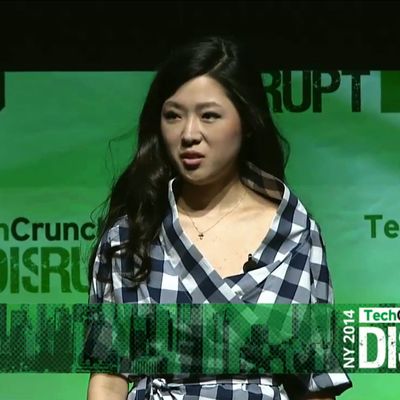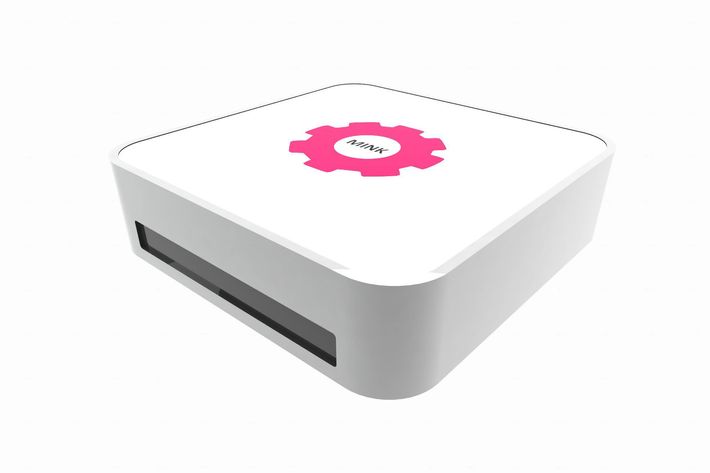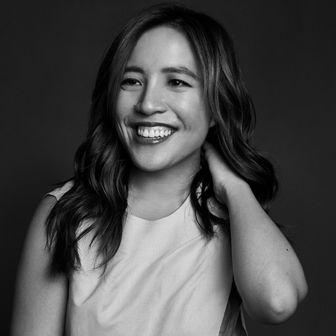
Grace Choi is ready to stage a beauty revolution that will cut through all of “the bullsh**” in the beauty industry. She told a group of shocked and awed participants as much last month, when she presented Mink, her 3-D printer for makeup (which she casually calls a “thingy-maker”) at TechCrunch Disrupt, explaining “the beauty industry makes a whole lot of money on a whole lot of bullsh**.” Choi then demonstrated how her printer could replicate an exact shade of pink eyeshadow seen in a Michelle Phan beauty tutorial, without the manufacturing processes or research and development or marketing of a beauty conglomerate.
While the physical and technical aspects of Choi’s venture are exciting, Choi has bigger, larger dreams for Mink, hoping that it disrupts not only beauty-company supply chains, but people’s perceived notions of beauty and diversity. The Cut spoke to Choi to learn about how she went from working at Burger King to creating 3-D-printed makeup, the secret inefficiencies of the beauty industry, and the revolution she hopes Mink inspires.
Tell me a little bit about how the idea for Mink came about.
It was sort of organic. I’ve been inventing or making stuff for a while. Manufacturing — that’s my thing. I really like understanding how things are made.
When I started at business school and was trying to make a cosmetics product I realized, Oh, this is how a cosmetic is made. And I thought, It’s so interesting how it’s so inefficient. [Laughs.] It wasn’t one kind of “ah-ha” moment. After I came back to New York from quitting my post-graduate job at Burger King (I know; it sounds so funny), I wanted to do something more meaningful and impactful. I decided I wanted to tackle challenges in the beauty industry.
The challenges are diversity issues and issues with women’s confidence. I thought, How can I solve these issues in a very simple way that has to do with a tangible product and a very simple design that has to do with manufacturing in the way that I know how to do it? I consider myself more of a creative, artistic person. I express myself through the medium of products. I remembered how the current process of manufacturing cosmetics sucks. I thought about how simple it would be if we used current technological products that are available, better made through ink-jet technology and using the internet. All these problems would be solved. It was a synthesis of time and issues.
You said the beauty industry was really inefficient. Inefficient in what way?
For instance, let’s say you want to make a BB cream. I wanted to make one and went to the manufacturing guy and I was like, “I want to make beauty cream for everyone. I want as many SKUs as possible. I want to make 50 shades for every single skin color and every single skin tone.” And he was like, “Sure, that’s going to cost you about a jillion dollars.” [Laughs.] And I’m like, “Why?” He said, “Well, we have these huge kettles and each kettle only makes one color at a time, and so if you want it, you’re going to have to pick one color or a few colors.” It’s very inefficient, because you have to decide which colors are going to be the most worth your money. And therein lies the problem of skin color and the beauty industry: You’re forced to decide which ones are the most important.
That’s the first time I faced that ethical dilemma, and I think that’s an ethical dilemma faced by a lot of beauty companies. That’s why on the store shelves, a lot of the colors that you see happen to be very fair-skinned Caucasian colors. Even the lipsticks or the eye shadows are all based on Caucasian or light-skinned colors, because they’re all very much based on this mass-manufacturing system in which you have to decide what is going to give you the most bang for your buck, because they’re all based on batch manufacturing. It’s industrialization, that’s what happened.
Beauty companies might say that they are being “efficient” by not making 50 different shades.
I guess efficient in the profit sense. I meant efficient in the sense of providing options for everyone. In the ‘50s, it was efficient for them because the internet didn’t exist and printing hadn’t happened yet. In the era that we live in now, I look at it and think it’s so inefficient. We have all this technology, and yet manufacturing and technology haven’t changed.
Even the stuff I use onstage, that technology is a lot more sophisticated than the stuff they’re using in the factories. In that sense, we can literally bring the factory to our doorstep now. That is what I mean by efficiency: being able to offer customization and more options to people.
Do you feel like you’re a little angry at the beauty industry?
I wouldn’t say I’m angry at any one person. I would say I’m angry at greed, because greed is what drives these beauty industries to make us feel like we’re not good enough. That’s how these companies make money — saying that we need this, or that we need to buy this to make us look prettier. I’m upset. I am. Because who are they to say “This is beautiful” or “This is pretty”?
I am angry, but I’m absolutely not closed off. I know they had no choice before. That was the model they needed to follow. Someone set the standard. I don’t know who set the standard. There was no other option before, but I’m just saying, “Hey, guys, there’s an option now. This is the option. Let’s talk about it.” And that’s all I’m saying!
I have liaisons at certain beauty companies, and they’ve been very receptive. Some of them don’t get it [laughs], and I understand because they’ve been so trained in this one way, but, you know, eventually they’ll get it. I think we just need to change the way that we’re thinking. I’m not angry at the beauty companies. I’m just angry at the way we’ve been thinking — they’ve been thinking, or greed has made them think for a while now. But now, let’s start talking about how we can fix it or change it. I’m open to this dialogue. Let’s work together at it, so we can all be less angry. [Laughs.] Because I don’t want to be angry!
So you feel like Mink is really about putting the power back in the hands of the consumer?
I don’t even want Mink to be the person to tell somebody, whether it be a woman or a man, what beauty is. Mink shouldn’t be that person. You shouldn’t be that person. I shouldn’t be that person. Nobody should be that person. The person who is using the computer should be that person; so, absolutely, you’re correct. I actually don’t care if Mink is the company that makes this happen, because my company alone, Mink alone, can’t. It’s market disruption, so I need other people to help me out. I need other companies to start. I need developers to come onboard. I need other printer companies to pop up. I need other segments to change the market.
This is literally a revolution and revolutions aren’t fought alone, and you need other people to help you. Honestly, it’s not Mink who is the be-all and end-all. I just want this idea to live. My wish out of all of this is that the idea that beauty is in the control of the person — the definition of beauty is in the control of the man or the woman, the user, and that’s it, and nobody else. It’s not about the beauty company or L’Oréal or Estée Lauder or your mom or whoever saying “This is beautiful” or “This is right” or “This is wrong.” No. It’s your decision to decide what’s pretty or not. That’s the only thing.

Where did you get the idea to combine 3-D printing and makeup? It’s a little unexpected.
It’s funny for me, because I don’t know if you even want to call it 3-D printing. I just call it a thingy-maker [laughs], because I don’t know what else to call it. It’s like an ink-jet, but it’s 3-D because it makes an object. It just got bookended as a 3-D printer because it makes a 3-D object, but essentially it’s a thingy-maker. You could call it an ink-jet printer that makes a 3-D object. It’s whatever you want, but it’s an object-maker.
I don’t know where it came from. It just happened. For instance, Steve Jobs probably saw something like what would become the iPhone or tablet on Star Trek and said, “How do I make this happen?” And he backed into it. That’s exactly how it happens.
For me, I had this crazy-ass idea and was like, It would be really cool if I were browsing a magazine, and I could just click on my tablet and make my makeup. How do I do that? Then it just comes to your mind. What’s available on the market right now? How can I do this? From all your past experiences, it’s just connecting the dots. You do feel guilty, because it’s not like really you did anything new. [Laughs.] I’m literally just pulling things together. I didn’t create ink-jet printing. I didn’t create makeup! I didn’t create new software. It all existed. I think that’s where the creative-person guilt comes from. We didn’t make anything new. We’re like conductors. We just pull things together, and it’s like, Voilà! So it’s nothing magical that happens. That’s where the ideas come from!
Where are you now in the development of Mink?
Right now, the prototype is pretty set. It’s very much moving. I can’t say very much about it, but it’s looking very good and will be executed in a way that I think is very unexpected. But again, it’s always been that … it’s never been about Mink the company or whatever. It’s always been the idea. It’s more about the movement: How do you get the movement to spread first, and the idea to spread? And then once you decide that’s the first priority, it’s very easy to just open up. Things have definitely been good. Hopefully, we’ll get this out very soon, and we’ll see from there what happens.





